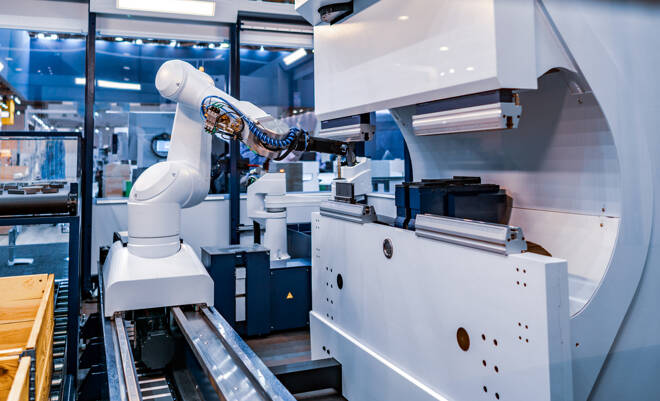Advertisement
Advertisement
German Industrial Production Rises 0.3% Versus a 0.6% Forecast
By:
German industrial production rises modestly in April. However, the latest factory orders and manufacturing PMIs signal more pain ahead.
In this article:
It is a busy day on the European economic calendar. The German economy was in the spotlight this morning, with industrial production numbers in focus.
Industrial production increased by 0.3% in April versus a forecasted 0.6% increase. In March, industrial production unexpectedly fell by a revised 2.1%.
According to Destatis,
- Production in industry excluding energy and construction rose by 0.1% in April.
- Consumer goods production increased by 1.5%.
- However, capital goods and intermediate goods production fell by 0.3% and 0.2%, respectively.
- Energy production also declined in April, falling by 1.5%.
- The manufacture of motor vehicles and parts slipped by 0.8%, while the manufacture of basic pharma products and pharma preparations increased by 6.4%.
The latest industrial production figures followed disappointing German factory orders for April and a weaker Manufacturing PMI for May. While industrial production rose in April, pressure on the German economy remains, with lackluster global demand a concern.
Earlier this morning, trade data from China set the tone. China’s USD trade surplus narrowed from $90.21 billion to $65.81 billion in May versus a forecasted $71.60 billion. Significantly, exports tumbled by 7.5% year-over-year, with imports down by 4.5%. Economists forecast exports to rise by 8.0% and imports to fall by 8.0%.
The economic indicators from China and the latest round of private sector PMIs from the US, Europe, and Asia will continue to test market risk sentiment. Further monetary policy tightening by the ECB would put the euro area at risk of a recession.
EUR/USD Reaction to German Industrial Production
Before the industrial production numbers, the EUR/USD rose to an early high of $1.07044 before falling to a pre-stat low of $1.06833.
However, in response to the industrial production numbers, the EUR/USD rose to a post-stat high of $1.06862 before falling to a low of $1.06802.
This morning, the EUR/USD was down 0.08% to $1.06840.
Next Up
Later in the European session, French trade data and Italian retail sales figures will also need consideration.
With the economic calendar on the busier side, investors should monitor central bank chatter throughout the Wednesday session. ECB Executive Board members Luis de Guindos, Fabio Panetta, and Edouard Fernandez-Bollo are on the calendar to speak today. Dovish commentary would catch the markets by surprise.
Turning to the US economic calendar, it is another quiet US session. US trade data will need consideration early in the session. However, barring a sharp widening in the trade deficit, the numbers should have a limited impact on market risk sentiment.
While the economic calendar is light, no FOMC members are speaking today. The Fed entered the blackout period that ends on June 15.
According to the CME FedWatch Tool, the probability of a 25-basis point June interest rate hike slipped from 24.1% to 19.4% on Tuesday versus 66.6% one week earlier.
About the Author
Bob Masonauthor
With over 20 years of experience in the finance industry, Bob has been managing regional teams across Europe and Asia and focusing on analytics across both corporate and financial institutions. Currently he is covering developments relating to the financial markets, including currencies, commodities, alternative asset classes, and global equities.
Did you find this article useful?
Latest news and analysis
Advertisement
